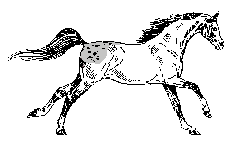
T1 Tölt B-Final, WC Icelandic Horses , Islandpferde-WM, VM Islandshästar, 2013
My first horse was a thoroughbred. "Little Bee", pasture name, "GoVanGough" racing name, taught my husband, Bill, our daughter, Lindsey, and myself how to ride a good balanced seat. Since Little Bee we have had a variety of horses including: Tennessee Walkers, Rackers, Kentucky Mountain Horses, and Spotted Mountain Horses. All but Little Bee were of the gaited variety. Since we learned to ride English we allowed all of our "gaited" horses to trot, as well, albeit on command. (Good training by us!) This is considered a NO-NO in the gaited world of horses as it is "breaking gait". We enjoyed jumping and did not want to do that from a four-beat gait. In short, we encouraged our gaited horses to be fully 5-gaited which included the trot. We always tried to train out the pace (uncomfortable to ride) although stepping pace aka broken pace was allowed if they were so inclined to do so. So--we understand Engligh riding, Western riding and Saddle Seat--how the rider places his/her body as well as how the horse moves to accommodate that placement. The ride is easier than the thoroughbred, however, I believe that the 5 gaited horses are really more complicated to ride and train properly for pleasure riding.
"Locomotion in mammals relies on a central pattern-generating circuitry of spinal interneurons established during development that coordinates limb movement. These networks produce left-right alternation of limbs as well as coordinated activation of flexor and extensor muscles. Here we show that a premature stop codon in the DMRT3 gene has a major effect on the pattern of locomotion in horses. The mutation is permissive for the ability to perform alternate gaits and has a favourable effect on harness racing performance. Examination of wild-type and DMRT3-null mice demonstrates that DMRT3 is expressed in the dI6 subdivision of spinal cord neurons, takes part in neuronal specification within this subdivision, and is critical for the normal development of a coordinated locomotor network controlling limb movements. Our discovery positions DMRT3 in a pivotal role for configuring the spinal circuits controlling stride in vertebrates. The DMRT3 mutation has had a major effect on the diversification of the domestic horse, as the altered gait characteristics of a number of breeds apparently require this mutation.
Horses show considerable variation in the pattern of locomotion. The three naturally occurring gaits in all equids are, in order of increasing speed, walk, trot and canter/gallop. Some horses can use alternate gaits, typically at intermediate speed, and 'gaitedness' is a trait upon which many specialized breeds have been developed. Based on variation in footfall pattern, timing and cadence, these alternate gaits can be generally divided into four categories: pace, regular rhythm ambling, lateral ambling and diagonal ambling...Pace is a two-beat gait in which the horse moves the two legs on the same side of the body in a synchronized, lateral movement ...in contrast to the trot, where the diagonal front and hind legs move forward and backward together....Ambling gaits are four-beat gaits in which footfall pattern, foot placement and timing are often unique to specific breeds....It is a regular ambling gait characteristic of the Icelandic horse. Many Icelandic horses also have the ability to pace and test scores for pace show a bimodal distribution (Fig. 1c) and high heritability, in the range 0.60-0.73 (ref. 3). ..." LETTER doi:10.1038/nature11399 Mutations in DMRT3 affect locomotion in horses and spinal circuit function in mice
For More Information:
Vikings Possibly Spread Smooth-Riding Horses Around the WorldIn Damascus, Ancient Appeals
Horse Gaits Regular and Artificial (Footfalls)
Riding, Training, Conformation Differences and Equipment for Gaited Horses

